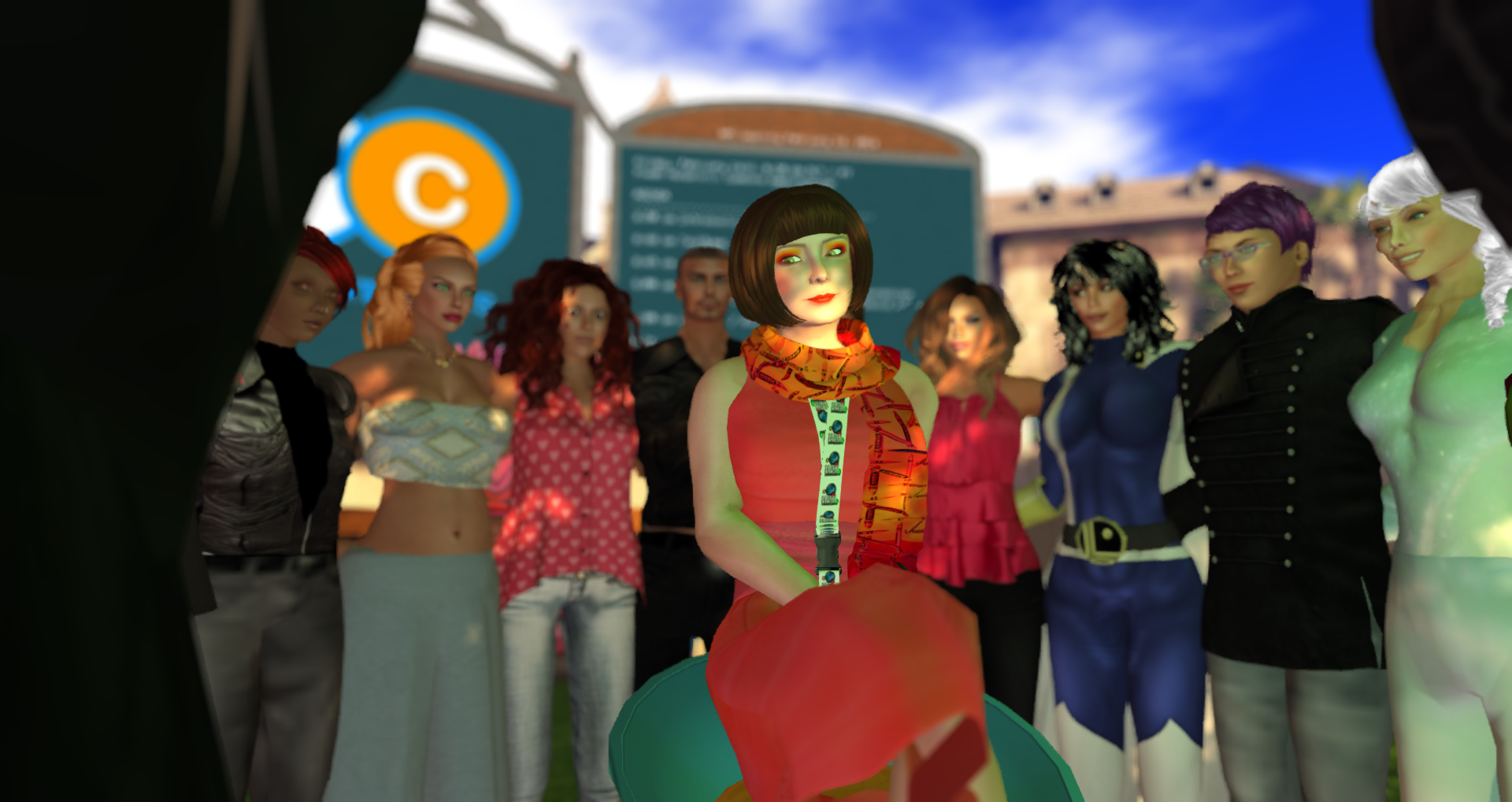Hi. Penguin asked me to cross-post my blog entry “Get a (Second) Life” about the Netsquared event from my newbie perspective. For your reading enjoyment …
I attended TechSoup’s NetSquared Conference today in Second Life about the launch of the Nonprofit Commons 2. If that sentence doesn’t make any sense to you, don’t worry. I’ll explain. Up until now, I have been avoiding Second Life – an online virtual world where you can meet people, shop, fly, do lots of fun stuff. It took me years to get over my computer game addiction and I don’t need another distraction from my job search. But now I find that nonprofits are using Second Life to spread their message, fundraise, and even fulfill their missions “in world.” I had to check that out.
It was a “mixed reality” event, meaning that the live conference was occurring in California while in Second Life our avatars were observing the panel discussion and participating in a virtual tour of the new Nonprofit Commons afterward (this is actually the second one). TechSoup, an organization that offers free and discounted software and technical expertise to nonprofits, manages both Nonprofit Commons and offers nonprofits free, virtual office space. The panel discussion featured some of the tenants.
There were some technical difficulties getting the sound to work so we missed the first half of the panel. I was having plenty of technical difficulties of my own. I just joined Second Life this morning and had a lot to learn. Once you create your avatar, you are taken to “Help Island.” There you can learn about your new virtual life and there are helpful volunteers to answer your questions. In my case, there was also a Romanian man who wanted to chat me up. I didn’t have much time for help or chatting because I had to get to the conference. Unfortunately, once you leave Help Island, you can’t go back. So, if I want to continue using Second Life, it will involve a lot of trial and error. My avatar, Carin Finesmith, stood throughout the presentation because I couldn’t figure out how to make her sit. Fortunately, she’s in better shape than I am and didn’t find it too taxing.
Here’s what I learned from the three speakers I heard:
First was Jani Myriam, founder of the Transgender Resource Center (TRC). She talked about how Second Life (SL) was a safe, anonymous place for her to explore gender issues in a way that was not safe in the “real world” and eventually lead her to make substantial real world changes in her life. Jani saw a need and a solution so she created the Transgender Resource Center as a way to provide support to transgender people in Second Life. They now have 800 members, so they must be doing something right. Jani mentioned it’s a much more affordable way to be a philanthropist than the real world (there’s no way she could afford office space in the Bay area). Other important benefits for a first-time philanthropist were access to resources and training from TechSoup and connections with other nonprofits. As far as I can tell, TRC only exists in SL. That’s one model that works well for a very specific population.
The next speaker was Jessica Dally from Community Voicemail (CVM) – very much a real life organization that provides voicemail services to people in crisis. CVM was introduced to the possibilities in Second Life through their major technology partner, Cisco Systems. Apparently, Cisco has a large presence in SL. Jessica mentioned it was helpful that she had some personal experience with SL because it’s not easy to jump into. (I was thinking “yeah, you can say that again.”) She said the biggest advantage was making connections with other nonprofits. They can’t have an office in every city, so they rely on partnerships with other nonprofits on a local level. She also mentioned the opportunity to meet people you wouldn’t otherwise (like the CTO of voice solutions for Cisco). This model was very interesting to me. I figured that people who don’t have access to voicemail also don’t have access to Second Life. But CVM isn’t using SL to connect with those they serve. This was a great way to make and strengthen partnerships.
The last speaker was Rik Riel from Global Kids. This is a 20-year-old nonprofit for teens in New York City, so it definitely pre-dates Second Life. SL allows them to reach new populations of teens – outside New York, with disabilities, even a group of incarcerated teens. Because they serve teens, it’s not surprising that Global Kids has some of the most creative uses of SL and the most seamless combinations of SL and real life. They also are active in more than one virtual world, but Rik didn’t talk much about that. Global Kids sees Second Life as a virtual place to promote real-world change. They have a program called “Dream It, Do It” where teens can propose projects to benefit their community, find funding, and manage the project. They also hold a lot of events in SL, including a live simulcast of Kofi Annan receiving an award from the MacArthur Foundation and trials from the International Criminal Court with lawyers providing running commentary for context.
Lastly, Rik answered a question that had been buzzing in my head – what about the kids who don’t have internet access. Global Kids is working on a project called “Switchboard” that allows users to exchange SMS text messages with people in the virtual world. The first test case they are planning involves teens in a refugee camp in Chad. How cool is that?
Rik’s slides are available at Slideshare. I looked at them so I could see what I was missing since I couldn’t get the presentation to work. Like all good Powerpoints (there are so few of them) the slides weren’t much use without the presenter. However, coincidentally (or not) I found on the Nonprofit Commons wiki a white paper titled “Best Practices for Non-profits in Second Life” from Global Kids which looks pretty good. I intend to read it soon.
Lastly, I got a magic carpet ride tour of the Nonprofit Commons. It is home to dozens of organizations from all over the world – too many to list here. Some, like Giving Circles, I had never hear of and others, SPCA are well known. It’s not just about information exchange, our tour guide mentioned that Kiva, which provides micro-loans, has a tip jar in their office that raises real money. The International Humanities Center acts as a fiscal sponsor for small organizations without 501c3 status. I may pay them another visit for Marketers Making a Difference. Also unique to SL is Garden For The Missing. It’s a virtual garden which displays posters of missing persons. All missing persons posters are clickable so that you can read more about their disappearances. There were also a few art galleries, hang gliding, canoe rides, sky diving, and a swimming pool. I feel a new addiction coming on.
Written by: Carin

